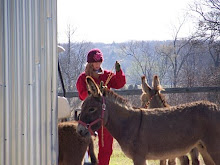Nephew built frames using 1/2 inch plywood as a base and some sort of coated wood. It's not melamine, which every tutorial I saw suggested, but it has a very smooth surface and will hopefully release without sticking to the concrete.
He also welded rebar to strengthen the countertop. I've watched and read several tutorials and, although there needs to be some reinforcement, rebar is not necessary for countertops. Most of the tutorials used a mesh like chicken wire. But, since we are having a twelve inch overhang with nothing to support it from underneath, we needed some extra strength on that side. This is a bit of an overkill, but if the homeowners don't like the countertop, they can always take it off and park the tractor on it.
We put a frame up under the overhang to keep it level until the concrete hardens.
I totally forgot to take pictures from here until the end. I was going to strap my GoPro camera to my forehead and do a video tutorial, but the camera wouldn't work. NOTE: The GoPro is a nifty little gadget and I know there are lots and lots of GoPro videos out there, but I have found it to not be user friendly and I've been having a problem with mine not recognizing the SD card in it, so it won't work.
Here it is after the pour and after we screed it twice. Screeding is taking a straight edged board, like a two by four and resting it on the forms, having it span the whole width. Move the board with a sawing motion all the way down the length. It pushes all the extra concrete off and levels and smoothes the surface. Our concrete was too wet, but I think it's going to be OK. We screed it two or three times, let it set for a couple of hours, then came back and screed it two or three more times until there was no more excess concrete coming off.
I vibrated the form by running the orbital sander around the edges of the forms and the places where I could reach up under the countertop. We had lots of bubbles.
After this, I went home and left Nephew to do the rest. After it set up so that it could be pressed without leaving much of a mark, he troweled it, then waited and troweled again. All told, I think he did it about six times and got a nice smooth surface. Troweling it like that pushes out the air bubbles and helps the concrete "cream" to rise to the top. At least, that's what the concrete guru, Buddy Rhodes, says.









2 comments:
I wish you could come and redo,our kitchen.
Someday maybe we'll get the chance to do something like this together.
Post a Comment